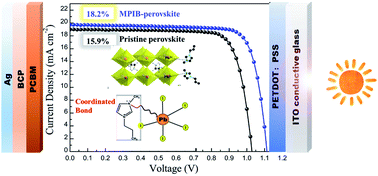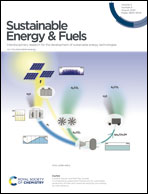Passivation of defects in inverted perovskite solar cells using an imidazolium-based ionic liquid†
Abstract
During perovskite film preparation, the defects in the film are almost impossible to avoid because of the migration of the halide ions, which is detrimental to achieving a high-quality film. In general, the introduction of an additive is an effective strategy to control the film morphology and to reduce the defect density. Here, the representative and simplest ionic liquid, 1-methyl-3-propylimidazolium bromide (MPIB), is selected as an additive due to its high conductivity and lone-pair electrons in its cationic group. Remarkably, the addition of the MPIB additive into the perovskite film improves the power conversion efficiency (PCE) from 15.9% for the pristine device to 18.2%. With the help of characterization analysis by scanning electron microscopy, X-ray photoelectron spectroscopy, Fourier transform infrared spectroscopy, etc., two contributions of the MPIB additive are addressed: (1) the primary one is the passivation of the uncoordinated Pb2+ to reduce the defects in the perovskite film by the lone-pair electrons in its cationic group, and (2) the secondary one is beneficial to promote crystal growth to improve the film quality. Hence, this work provides an easy approach to achieve a high-performance perovskite solar cell via passivation of the uncoordinated Pb2+ in the perovskite film by the lone-pair electrons in the cationic group of the ionic liquid.



 Please wait while we load your content...
Please wait while we load your content...